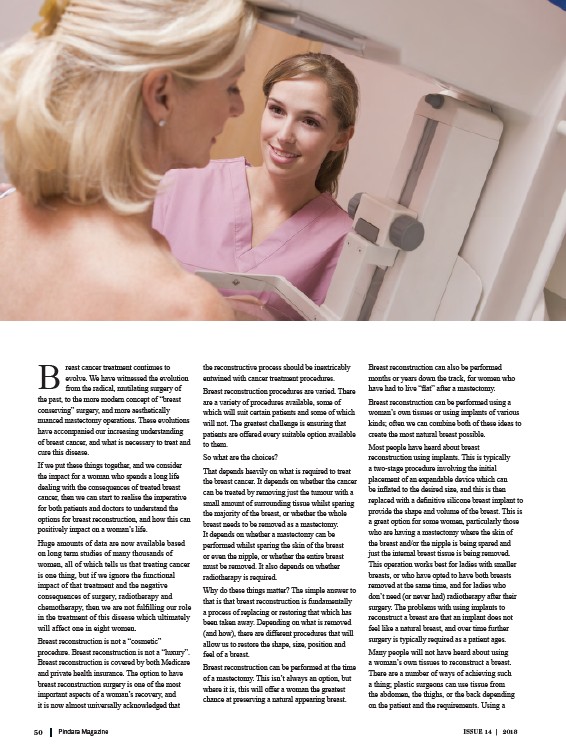
reast cancer treatment continues to
evolve. We have witnessed the evolution
from the radical, mutilating surgery of
B
the past, to the more modern concept of “breast
conserving” surgery, and more aesthetically
nuanced mastectomy operations. These evolutions
have accompanied our increasing understanding
of breast cancer, and what is necessary to treat and
cure this disease.
If we put these things together, and we consider
the impact for a woman who spends a long life
dealing with the consequences of treated breast
cancer, then we can start to realise the imperative
for both patients and doctors to understand the
options for breast reconstruction, and how this can
positively impact on a woman’s life.
Huge amounts of data are now available based
on long term studies of many thousands of
women, all of which tells us that treating cancer
is one thing, but if we ignore the functional
impact of that treatment and the negative
consequences of surgery, radiotherapy and
chemotherapy, then we are not fulfilling our role
in the treatment of this disease which ultimately
will affect one in eight women.
Breast reconstruction is not a “cosmetic”
procedure. Breast reconstruction is not a “luxury”.
Breast reconstruction is covered by both Medicare
and private health insurance. The option to have
breast reconstruction surgery is one of the most
important aspects of a woman’s recovery, and
it is now almost universally acknowledged that
the reconstructive process should be inextricably
entwined with cancer treatment procedures.
Breast reconstruction procedures are varied. There
are a variety of procedures available, some of
which will suit certain patients and some of which
will not. The greatest challenge is ensuring that
patients are offered every suitable option available
to them.
So what are the choices?
That depends heavily on what is required to treat
the breast cancer. It depends on whether the cancer
can be treated by removing just the tumour with a
small amount of surrounding tissue whilst sparing
the majority of the breast, or whether the whole
breast needs to be removed as a mastectomy.
It depends on whether a mastectomy can be
performed whilst sparing the skin of the breast
or even the nipple, or whether the entire breast
must be removed. It also depends on whether
radiotherapy is required.
Why do these things matter? The simple answer to
that is that breast reconstruction is fundamentally
a process of replacing or restoring that which has
been taken away. Depending on what is removed
(and how), there are different procedures that will
allow us to restore the shape, size, position and
feel of a breast.
Breast reconstruction can be performed at the time
of a mastectomy. This isn’t always an option, but
where it is, this will offer a woman the greatest
chance at preserving a natural appearing breast.
Breast reconstruction can also be performed
months or years down the track, for women who
have had to live “flat” after a mastectomy.
Breast reconstruction can be performed using a
woman’s own tissues or using implants of various
kinds; often we can combine both of these ideas to
create the most natural breast possible.
Most people have heard about breast
reconstruction using implants. This is typically
a two-stage procedure involving the initial
placement of an expandable device which can
be inflated to the desired size, and this is then
replaced with a definitive silicone breast implant to
provide the shape and volume of the breast. This is
a great option for some women, particularly those
who are having a mastectomy where the skin of
the breast and/or the nipple is being spared and
just the internal breast tissue is being removed.
This operation works best for ladies with smaller
breasts, or who have opted to have both breasts
removed at the same time, and for ladies who
don’t need (or never had) radiotherapy after their
surgery. The problems with using implants to
reconstruct a breast are that an implant does not
feel like a natural breast, and over time further
surgery is typically required as a patient ages.
Many people will not have heard about using
a woman’s own tissues to reconstruct a breast.
There are a number of ways of achieving such
a thing; plastic surgeons can use tissue from
the abdomen, the thighs, or the back depending
on the patient and the requirements. Using a
50 Pindara Magazine ISSUE 14 | 2018